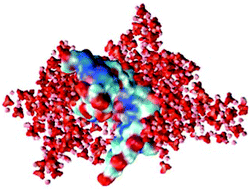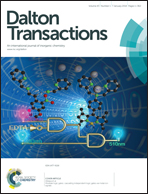Mineralization of DNA into nanoparticles of hydroxyapatite
Abstract
Encapsulation of DNA into hydroxyapatite (HAp) has been investigated using a rational approach that involves computer simulation and experimental techniques. The temporal evolution of the radial distribution functions derived from atomistic molecular dynamics simulations of Ca2+, PO43− and OH−-containing aqueous solutions in the presence and absence of B-DNA has been used to conclude that the backbone of the double helix acts as a template for HAp growth. More specifically, results reveal the formation of calcium phosphate clusters at the first stages of the simulations, which subsequently re-organize to nucleate HAp. This effect is produced in the absence and, especially, presence, of DNA indicating that the biomolecules do not inhibit but even promote mineral growth. Furthermore, computer simulations suggest that the diffusion of the OH− anions through the inorganic solution is the limiting step for the nucleation of the biomineral. Nanocapsules and crystalline nanorods of HAp containing DNA molecules inside have been prepared by mixing solutions containing Ca2+ and PO43− ions with fish sperm DNA at high pH. The dimensions and morphology of such nanostructures have been examined by transmission electron microscopy, while the characterization of the biomineral has been focused on the identification of DNA inside HAp using infrared, X-ray photoelectron and UV-vis spectroscopies, as well as gel electrophoresis. The biominerals reported in this work are important for biomedical applications requiring the protection of DNA from aggressive environmental conditions.


 Please wait while we load your content...
Please wait while we load your content...